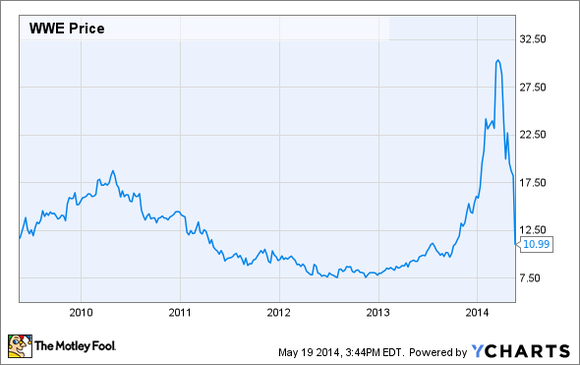World Wrestling Entertainment (NYSE: WWE) shareholders have spent most of the past few weeks in shock after witnessing the stock take a swan dive from all-time highs of about $32 in March to below $11. On the surface, the company appears as successful as ever, so how could this disaster possibly have happened? It turns out that, despite the popularity of the company in recent years, WWE shareholders recently found themselves in the center of a perfect storm that developed around WWE stock. So what can WWE shareholders learn from this experience, and how does their experience compare to the experiences of Facebook (NASDAQ: FB)shareholders after Facebook’s disastrous IPO in 2012?
High Expectations
As I have written before , high expectations are a shareholder’s worst enemy. And yet many optimistic investors get caught up in the excitement of pending news, earnings rumors, or buyout hopes. Their misguided intuition tells them that they know good news is coming, and if they simply buy stockbefore the news comes out, the share price will skyrocket once the news is official. In the case of WWE, the “big news” items were the launch of the WWE Network in February and the new television deal with NBC Universal announced on Friday.
If you take a look at a chart of WWE over the past few years, it’s easy to see when expectations started to build in late 2013.

Bad numbers
Certainly some of the blame for shareholders’ unrealistic expectations for the WWE Network and the television deal rests squarely on the shoulders of the WWE itself. In December, Chief Strategy and Financial Officer George Barrios compared the company’s upcoming TV deal to Nascar’s $820 million annual TV deal with Fox and NBC. [ ]
On Friday, WWE announced that its new deals to continue to air Raw on USA Network and Smackdown on Syfy would be in the neighborhood of $200 million, a far cry from Nascar’s $820 million.
[ ]
As far as expectations for the WWE Network go, WWE has been actively promoting the network on Raw as “just like Netflix, but better!” [ ]
With only about 667,000 confirmed subscribers to the fledgling WWE Network, comparisons to Netflix and its nearly 50 million subscribers [ ]might not be the best way for WWE to temper high expectations. Although the WWE Network reached 667,000 subscribers in only 42 days, WWE itself projects that even increasing the number of subscribers by 50% to 1 million by the end of 2014 would result in a net loss of $45 to $52 million for the company. [ ]
Between unreasonably high expectations for the new TV deal and the WWE Network, shareholders lost their grip on reality at some point during the past few months. If you look at the overall performance of the company, you can see the stock had no business ever being near $30. Take a look at a plot of WWE’s EBITDA, revenue, and share price over the past five years.

As you can see, the 350% increase in WWE share price during 2013 and early 2014 was not accompanied by any meaningful change in revenue, and earnings actually decreased during that time to five-year lows.
Rookie mistake
So how is it that WWE stock got so overpriced? As I said, it’s not uncommon for stocks to become overpriced because of overly optimistic shareholders, but a 66% drop in a few months is fairly extreme. I believe that the nature of the WWE shareholder base played a role in the WWE “bubble.” Professional wrestling has a large, well-documented online cult following . Many of these wrestling super-fans keep abreast of behind-the-scenes wrestling news just as much as they follow the on-screen story lines. With the meteoric rise in WWE stock during the latter part of 2013, it comes as no surprise that WWE stock became a topic of much discussion among wrestling fans. I can only assume that many of these fans, whose stock market acumen is likely not as solid as their pro wrestling knowledge base, got sucked into the “irrational exuberance” of the WWE stock frenzy.
What can WWE learn from Facebook?
When I read comments on pro wrestling message boards by shareholders citing brand loyalty, lack of competition, and TV ratings as reasons for buying WWE stock, it reminds me of the types of things I was reading and hearing about Facebook prior to its infamous IPO. Sure, high TV ratings are indirectly good for WWE and can be used to gauge the popularity of its programming. But when it comes to making money, the weekly Raw ratings have about as much to do with WWE’s bottom line as the number of free Facebook subscribers had on Facebook’s bottom line in 2012. Unless WWE can figure out a way to monetize its popularity, as Facebook has over the past several quarters , WWE stock will likely not be back at $30 anytime soon.


